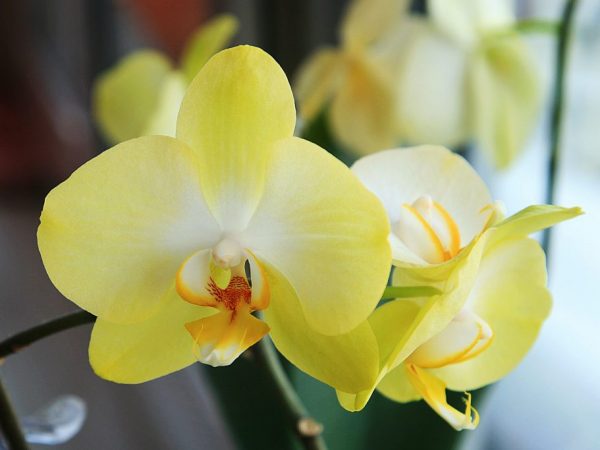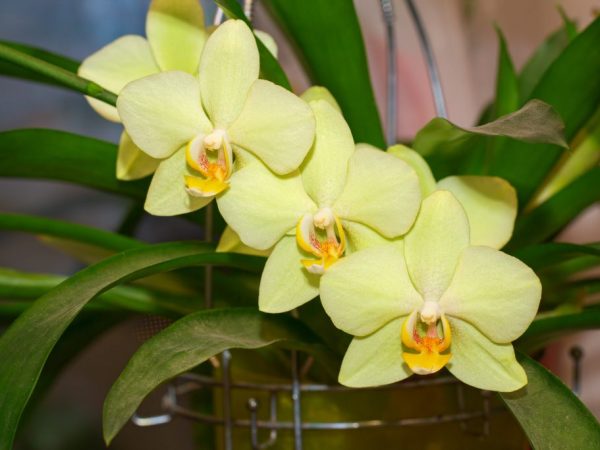Growing Lemon Orchid
The lemon orchid was developed in the early 21st century in Holland. This plant was immediately recognized as one of the best varieties of this flower. A distinctive feature of this species is the presence of not 1, but 2 stems. The culture is unpretentious to care for, so growing it at home is not difficult.

Lemon Orchid
Characteristics of the variety
Phalaenopsis Lemon variety has tall shoots. Their length is 20-30 cm. The height of the plant itself is 70 cm. Large flowers of different colors are formed in the upper part of the bush. Flowers of a yellow hue are more common. Often, yellow inflorescences with burgundy or blue blotches are formed.
Phalaenopsis Leaves Lemon rich green shade, elongated shape. Their surface is covered with a dense layer of waxy coating, which increases the shine in the sun. The root system is developed in a horizontal plane.
Growing rules
The best option for the soil in which the seedling is planted is coniferous bark. With its help, the plant is in an upright position and receives the required amount of air and nutrients. Such a substrate is bought in specialized stores or prepared at home. To do this, mix 3 kg of coniferous bark, 1 kg of wood ash and 500 g of peat.
The planting container should be transparent so that the root system receives the right amount of sunlight. A glass jar or plastic food container is the best option. Choose pots that are short and wide so that the roots are fully spread over the area of the container and the plant develops horizontally. The landing pattern is simple and consists of several stages:
- 2/3 of the substrate is poured into the pot;
- a seedling is placed to a depth of 5 cm;
- the roots should be distributed over the entire area of the container and sprinkled with soil evenly, paying special attention to the inter-root space;
- tamp the soil;
- water the plant after 5-7 days.
Reproduction and flowering period
The Phalaenopsis Orchid of the Lemon variety reproduces with the help of sprouts that form next to the main stem. Only those shoots that have formed their own root system are suitable for planting. Otherwise, the development and flowering of the culture will occur with a delay of 3-4 months. The culture should be transplanted into a new pot no more often than after 2-3 years. At this point, the substrate will become poor in useful elements and will begin to decompose.
The plant blooms from early October to late April. The dormant period lasts 5 months, during which the bush should be watered less often and the minimum amount of fertilizer should be applied. This will allow it to recover from prolonged flowering.

Lemon orchid flowering period
Care advice
Store a pot of Lemon Orchid in a well-ventilated area where indirect sunlight falls. It is better to place the plant in the northern or eastern part of the house, where the sun's rays are refracted and will not burn the leaves.The optimal daytime temperature for keeping the culture is considered to be 26-28 ° C. At night it is lowered to 17-19 ° C. This difference will increase the flowering time.
Lemon Orchid requires minimal watering. It is carried out with an interval of 14-18 days, with warm, settled water. The water temperature should be 27-30 ° C. Watering is carried out by immersing a container with a flower in a bowl of water. The duration of stay in the water should be 10-15 minutes. After that, the pot is set aside so that excess moisture in the glass. Top dressing is carried out with mineral components. They need to be brought in at intervals of 10-15 days. More often, solutions of superphosphate (50 g per 10 l of water) or potassium nitrate (40 g per 10 l of water) are used.
After the flower dries up and the dormant period begins, the shoot is pruned, on which the inflorescence was formed. The trim should be up to the level of the beginning of the sheet. This speeds up the flowering process.
Pest and disease control
The plant is often susceptible to diseases such as root rot and powdery mildew. Fighting root rot is pointless, since there are no tools that would eliminate the problem. The only option would be to remove the entire flower, right down to the roots. Watering the orchid with a manganese solution (5 g per 10 liters of water) is considered a means of combating powdery mildew.
Beetles are isolated from pests. The main symptoms of their appearance are spots on the surface of the leaf and dryness of the top of the plant. They should be dealt with with the help of the Lux-Effect preparation (40 g per 10 l of water).
Prevention measures
Prevention of pests and diseases involves processing the substrate before planting. All care recommendations should be adhered to in order to prevent the growth of bacteria that provoke diseases. With an interval of 2 months, the culture is sprayed with copper sulfate (30 g per 10 l of water).
Conclusion
Growing this orchid variety at home is possible if you adhere to all the rules for planting and caring for it. This will help the plant develop according to its natural growing season and form a strong root system. Protect the crop from diseases and pests that destroy its structure and appearance.


